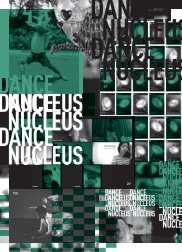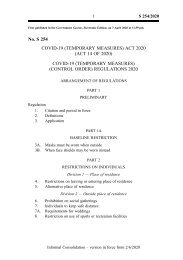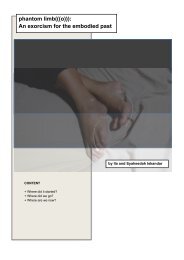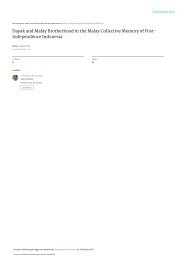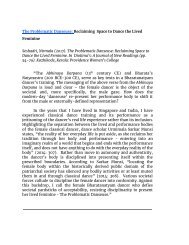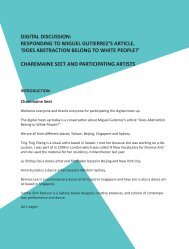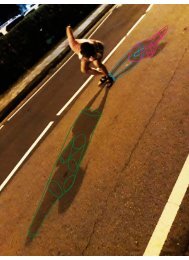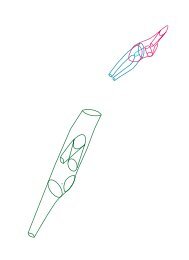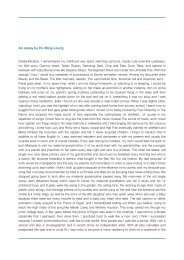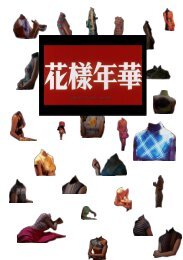FUSE#2
FUSE is a bi-annual publication that documents the projects at Dance Nucleus .
FUSE is a bi-annual publication that documents the projects at Dance Nucleus .
Create successful ePaper yourself
Turn your PDF publications into a flip-book with our unique Google optimized e-Paper software.
Element#2<br />
BAHASA KOREOGRAFI<br />
Lenggang Sebagai<br />
Permulaan sebuah<br />
Penelitian dan Praktek<br />
oleh Soultari Amin Farid<br />
Ethnochoreolog, Mohd Anis Mohd Nor (1993) menulis,<br />
“in all types of social Malay dance the male dancer is not permitted to dance like a<br />
woman. The beauty of Malay dance posits the male dancer as the protector and<br />
supporter of the female dancer. Even though their hands don’t touch each other,<br />
the dancing couple gives the impression that there is an understanding through the<br />
execution of movement in dance. The competency of the male dancer lies in the<br />
style of mannerism that is proud and manly and does not mimic the gracefulness<br />
of the woman… The steps and wrist motions of the male dancer is enlarged with<br />
the both hands opened widely to the sides of the body and swaying as if trying to<br />
4<br />
defend his dance space from being invaded upon by his competitors” (33).<br />
Cross-dressing in performance is a common occurrence in the<br />
dance and theatre of the Malay world. Performances of kindred<br />
communities such as the ethnic communities in Java, have gender<br />
fluid examples. Ethnomusicologist, Christina Sunardi, provides a<br />
historical sampling of these performances in early Indonesia in her<br />
book, “Stunning Males and Powerful Females: Gender and<br />
Tradition in East Javanese Dance”, listing the customs of males<br />
performing female roles in Ludruk, an East Javanese popular<br />
theatre; males personating females in a 19th century Banyuwangi<br />
dance called Seblang; the tradition of males performing central<br />
Javanese female court dances from the 18th century till the 20th<br />
century; and the possibility of females performing male characters<br />
in the masked dance of Cirebon, just to name a few (20-21).<br />
I use Mohd Nor’s scholarly words to think through what it means to perform the<br />
Lenggang in holistic manner (rather than just concentration of foot movements) and<br />
at same time critiquing the form with my own embodied queer experience of<br />
enacting the Lenggang. I ask whether Mohd Nor’s description of the gender-rigid<br />
performance in social and art dance of Malay dancing provides space for someone<br />
who does not necessarily agree with the imposition of rigid gender mannerisms on<br />
the body.<br />
I may agree to the rigid gender roles when a couple dances together but in cases<br />
when a male dancer is allowed to dance solo (which is actually not a convention in<br />
Malay dance since most dances are performed collectively), should not there be<br />
concessions for the inclusions of movements which may be deemed “female”<br />
without having it be relegated as taboo? In addition, If such an act is seen as a<br />
transgression, then where do we place performance traditions which predicated on<br />
art of cross-gender performance and dressing?<br />
4<br />
“Dalam kesemua jenis tari pergaulan Melayu penari lelaki pula tidak dibolehkan menari seperti seorang wanita.<br />
Keanggunan tari Melayu telah meletakkan mertabat penari lelaki sabagai pelindung serta pendamping penari wanita.<br />
Walaupun masing-masing tangan tidak bersentuhan dengan bahagian tubuh penari saingan, kedua-kedua penari<br />
seolah-olah kelihatan bersefahaman dalam perlaksanaaan gerak dalam tari. Kejaguhan penari lelaki terletak kepada<br />
gaya kelakuan yang megah dan jantan dan tidak yang meniru keayuan gemulai wanita. … Langkah dan lengangan<br />
tangan penari lelaki sentiasa menguak dengan membuka lebar-lebar kedua tangan ke samping tubuh beserta hayunan<br />
seolah-olah mengepung ruang tarinya dari di cerebohi oleh lawan…” (33)<br />
This is definitely a complex conundrum. I bring up the issue of<br />
cross-dressing because it is an act which entails the embodying of<br />
a character/movement style of the opposite sex (male dancer<br />
embodying a female character/mannerism or female dancer<br />
embodying a male character/mannerism). Indonesia and Malaysia<br />
have produced male personalities who are known for their<br />
cross-gender and/or effeminate dance acts: Didik Nini Thowok;<br />
Rianto; and Rosnan Abdul Rahman.<br />
After the intensive residency, I had time to think about the research<br />
materials I have acquired for this investigation. I critically reflected<br />
on why I am very focus on the Lenggang, especially when in<br />
solo-dancing, it is not pertinent for me to employ the movement<br />
phrase when I am improvising. I realized soon after that I was using<br />
the Lenggang as an object of analysis to think through what it<br />
means for the Queer body to embody rigid gender<br />
roles/performance and how the nature of the Queer body may<br />
challenge these boundaries. I see the learning of the Lenggang as<br />
foundational knowledge taught to amateur dancers and in the<br />
learning of the movement phrase, the transmission process is filled<br />
with knowledge about the gender norms in the dance.<br />
65 66




